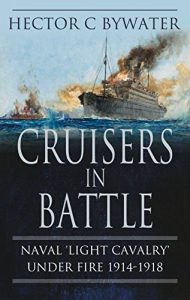During the First World War, the light cruiser and its satellite, the destroyer, were the first ships to go into action and the last to come out.
Between 1914 and 1918, the ubiquitous British cruisers could be found roaming the seas from China to Peru, the Arctic Circle to the Cape of Good Hope.
Like the light cavalry, their most distinguished duty was to scout for and screen the battle fleets; their most important mission, however, was to keep the trade routes clear.
From chance encounters and perilous minefields to more traditional actions against the German fleet, Bywater illustrates the many functions of the cruiser through the experiences of those crewing them.
Drawing heavily on both British and German official histories in order to produce a fair and objective picture, as well as the letters of those aboard during operations, ‘Cruisers in Battle’ is richly detailed in its charting of these naval cavalrymen under fire.
Hector C. Bywater (1884-1940) was a British journalist, military author and spy, primarily focused on naval affairs. His 1925 work The Great Pacific War correctly predicted many of the actions that the Japanese and Americans took during WWII; indeed, it was later revealed that many military leaders had used it as a resource in their strategic planning.






